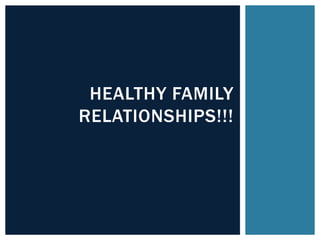
Family Relationships
- 2. JOURNAL Write about your favorite family tradition. What makes this tradition so great? When does it occur? Who participates?
- 3. FAMILY RELATIONSHIPS HEALTHY FAMILIES ARE THE FOUNDATION OF A HEALTHY SOCIETY.
- 4. WHAT IS A FAMILY? FAMILY: The basic unit of society What does family mean to you? Why is it be important to establish healthy families? Promoting healthy families contributes to a healthy society! How can we promote healthy families?
- 5. A HEALTHY FAMILY Members freely express mutual love & respect Members communicate effectively with one another Members provide support, protection, & encouragement to each other Members actively practice the 3 C’s of relationships: Communication Cooperation Compromise
- 6. FUNCTION OF THE FAMILY Culture & Tradition Emotional Needs Physical Needs Social Needs
- 7. HEALTH TRIANGLE Mental/Emotional Health Social Health Physical Health
- 8. HEALTH TRIANGLE Mental & Emotional Health Family members nurture and support one another. They contribute to a sense of belonging and a feeling of security. Physical Health The Family provides food, clothing, and shelter to its members. Family members also promote healthful behaviors and safety skills. Social Health The family helps its members develop communication skills and the ability to get along with others.
- 9. TYPES OF FAMILIES Nuclear Family: two parents and one or more children living in the same place . Single Parent Family: one parent caring for one or more children. Blended Family: consists of a married couple and their children from previous marriages (formed when a single parent remarries).
- 10. TYPES OF FAMILIES Extended Family: a family that includes additional relatives beyond parents and children. Adoptive Family: consist of a parent or parents and one or more adopted children. Can have both adopted and biological children. Foster Family: the temporary placement of children in the homes of adults who are not related to them.
- 11. STRESSES ON THE FAMILY Changes in Family Structure Birth and Adoption Separation and Divorce Remarriage Death of a family member Changes in Family Circumstances Moving to a new home Changes in the family’s financial situation Illness and disability Alcohol or other drug abuse
- 12. CHANGES OCCURRING IN THE FAMILY TODAY Dual Income How does this affect the family? Blended Families How can this cause stress in the family? Why is this a new situation we are being face with? Single Parents What difficulties can this cause? Why is this a new circumstance today?
- 13. BIRTH ORDER Birth order: The order in which children are born into a family influences the development of the children. Each group is to list the advantages and disadvantages of their birth order on the butcher paper. Each group will present their findings.
- 14. OLDEST CHILD Usually set up as an example to the other children. Treated more like an adult by his/her parents. A high achiever. Given and accepts more responsibility than the other children. Usually college-bound. Independent. Affectionate.
- 15. MIDDLE CHILD May work extra-hard to get recognition. Is usually a peacemaker. Is somewhat average in schoolwork, but is an all-around good student. Is usually a calm, even-tempered adult.
- 16. YOUNGEST CHILD Gets a lot of attention, along with a lot of bossing. May be spoiled. Usually matures quickly. May be undisciplined and irresponsible. Is easy-going about school. Likes to associate with someone who takes charge of situations.
- 17. HOW TO STRENGTHEN FAMILY RELATIONSHIPS… MAKE DEPOSITES!!!!! “You are 100% responsible for 50% of the relationship!!” Demonstrate care & love Show support, especially during difficult times Demonstrate trust Express commitment Be responsible Spend time together Respect individuality Work together to solve problems Be sensitive to others’ needs